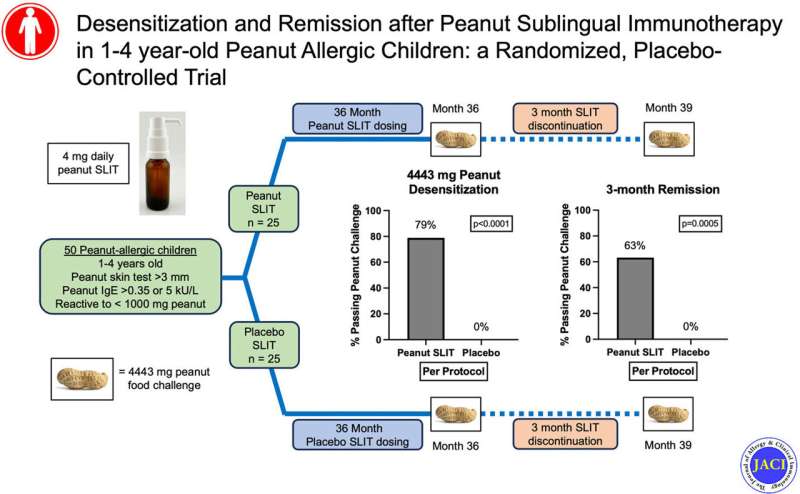This article has been reviewed according to Science X's editorial process and policies. Editors have highlighted the following attributes while ensuring the content's credibility:
fact-checked
peer-reviewed publication
trusted source
proofread
For toddlers allergic to peanuts, a tiny bit of protein therapy under the tongue could be the best approach

A three-year clinical trial has shown that the sublingual immunotherapy, or SLIT, is safe in peanut-allergic children ages 1 to 4, with a greater likelihood of desensitization and remission the earlier the treatment began.
Led by Edwin Kim, MD, associate professor of pediatrics at the UNC School of Medicine, this is the first randomized, controlled trial to investigate—in this young age group—the efficacy and feasibility of SLIT, which involves a tiny bit of peanut protein absorbed under the tongue.
The study, published in the Journal of Allergy and Clinical Immunology, included peanut-allergic 1- to 4-year-old children randomized to receive 4 mg peanut SLIT versus placebo. A total of 50 participants (40 at UNC Medical Center, 10 at University of Texas Southwestern Medical Center) were enrolled. Participants were randomized 1:1 with 25 receiving peanut SLIT and 25 receiving placebo.
It's an approach where the treatment is given as a small amount of liquid under the tongue, instead of peanut flour that is mixed with other food and then eaten like it is during oral immunotherapy, or OIT. Desensitization to peanut was assessed by double-blind, placebo-controlled food challenge (DBPCFC) after three years of treatment.
Findings showed that peanut SLIT can be highly effective in treating peanut-allergic toddlers with almost 80% tolerating 15 peanuts without allergic symptoms after completing the treatment. With most typical peanut-allergic reactions being caused by one peanut or less, these results would translate into strong protection against exposures to peanut. In addition, researchers showed that remission of the peanut allergy may be possible after peanut SLIT with 63% of the toddlers maintaining their protection three months after stopping the treatment. These new findings show that early intervention with peanut SLIT is promising and warrants further development.
"From our prior studies in older children, we were optimistic that peanut SLIT could have a similar treatment effect in toddlers," said Kim, corresponding author of the study, pediatric allergy and immunology division chief and director of the UNC Food Allergy Initiative. "However, what we found was even better. The desensitization levels we saw were higher than expected and on par with levels we normally would only expect with oral immunotherapy. Just as important, rather than wearing off quickly, we were excited to see that over 60% stayed protected three months after stopping the treatment."
One of the presumed strengths of the SLIT approach when compared to OIT has been its overall safety and simple administration. While most treatment side effects with OIT are mild to moderate, severe reactions requiring emergency treatment do occur and there remains a critical need to develop treatments with more manageable side effects.
"Peanut OIT is currently available and being offered by increasing numbers of allergists, however we are quickly learning that in addition to its known risk of allergic reactions, the actual doing of OIT can be very difficult for many families," said Kim. "Peanut SLIT could be a good option to consider as it may be able to provide comparable levels of protection while being safe and easier to administer."
Compared to OIT, the SLIT approach is likely to be a safer option, Kim said, with the most common side effect consisting of oral itching. Treatments that can protect children from allergic reactions while still being safe and practical for busy families can be life-changing, and researchers are hopeful that peanut SLIT can be one of those options.
"Even with the push to introduce peanut in early childhood in order to prevent the allergy, peanut allergy remains one of the most common food allergies," said Kim. "A result of early peanut introduction is that we are diagnosing peanut allergy at younger and younger ages making it vitally important to develop treatments that can be safe and effective at preventing allergic reactions in these young children."
More information: Edwin H. Kim et al, Desensitization and remission after peanut sublingual immunotherapy in 1- to 4-year-old peanut-allergic children: A randomized, placebo-controlled trial, Journal of Allergy and Clinical Immunology (2023). DOI: 10.1016/j.jaci.2023.08.032




















